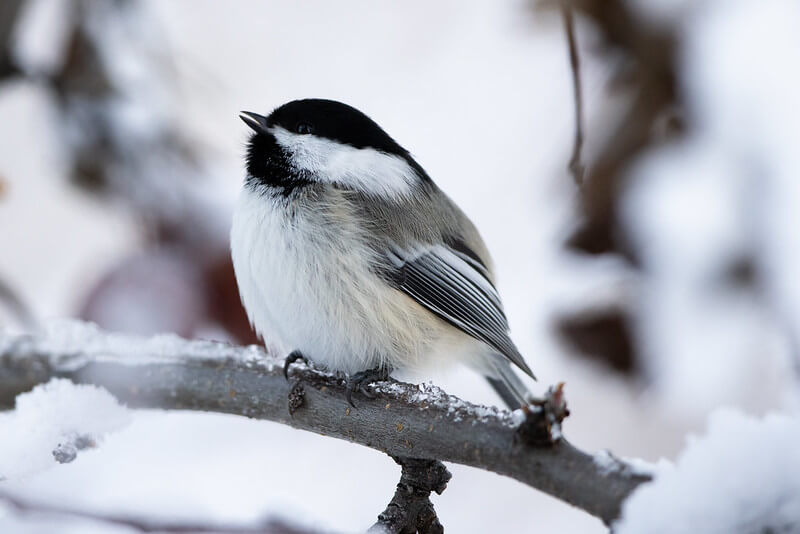Growing Their Brain is Just One Way Black-Capped Chickadees Survive the Winter
by Linda Pilsworth
Broadcast 12.8 & 12.11.2021

Black-capped Chickadees are a common sight (and sound) in winter, and they have many adaptations that help them survive. Photo by Lisa Hupp/USFWS (public domain).
Listen:
It’s only late October and a polar express sweeps down upon us with frigid temperatures, wind and snow. I watch from my warm living room as Black-capped Chickadees flit from the feeder to the spruce and back. I think of a song called “Little Chickadee” often requested on a local radio station’s children’s program, and I am reminded why this tiny creature is one of my favorite birds. The chickadee in the song is “only a common backyard bird,” not “some fancy colored thing.” Yet she can “fly anywhere she cares to roam” and can “call anywhere her home.” And her home can be anywhere in a vast part of Alaska, Canada, or the whole northern half of the United States! We easily recognize these little songbirds with their solid black caps and bibs and white cheeks. They have adapted extremely well to living among humans and are frequently at our feeders.
But what about those I almost always encounter when I hike the nearby forest trails? How do such tiny birds find enough food, stay warm, and survive into the next spring far from ready supplies of seeds, suet, or peanuts? Malnutrition is a major cause of winter mortality in chickadees. It reduces their ability to withstand cold temperatures and to resist disease. To counter this, they must eat continuously during the day, spending up to twenty times more time eating in winter than they do in the warmer seasons. Their winter diet is fifty percent animal (insects and spiders), fifty percent plant material (seeds and berries). They also consume fat from any carrion they can find.
In autumn when food is abundant, chickadees work hard at caching. They “scatter hoard,” stashing each item in a different spot. A single chickadee can store up to one thousand seeds a day, or eighty thousand a season. Where do they hide these seeds? In any crevice they can find – under a piece of bark, or in a cluster of fir needles or leaves. Incredibly, a chickadee remembers exactly where each cache is! How does its tiny brain do that? The chickadee’s brain has developed an amazing adaptation: each fall, its brain sheds some old neurons and grows new ones. Like other birds that live in cold climates and rely heavily on stored food, the chickadee’s hippocampus, the part of the brain that involves spatial memory, grows thirty percent larger in the fall and then shrinks again in the spring when that ability is less needed.
With an adequate food supply, the chickadee is able to maintain its metabolism and stay warm enough during the day. But winter night temperatures are usually much colder than in daytime. So how does our chickadee stay warm when the sun goes down? Does she huddle with her flock as many small birds do? With flock mates close by, Black-capped Chickadees roost most often in their very own spots. A chickadee can excavate its roosting site in soft rotted wood or take refuge in thick conifers, old woodpecker holes, and even bird boxes. Additionally, chickadees have the ability to lower their body temperature for short periods. This state of controlled hypothermia is called torpor. It allows the chickadee to conserve energy.
Of course predators are a threat to survival year-round. One strategy for reducing this threat in the non-breeding season is to join in with mixed flocks of other small winter birds. I often see chickadees in mixed flocks of nuthatches, and often a Downy Woodpecker is close by. Other birds seem to understand the chickadee’s alarm call. This allows them to forage more while relying on the chickadee to warn them of danger. The Downy Woodpecker especially depends on chickadee sentinels. More eyes equal greater opportunities to detect predators and also greater opportunities to learn about and find new food sources.
Having learned all this, I love chickadees even more. Who knew they perform guard duty in flocks of other winter birds? Or that their brains grow more memory cells in the fall so they can remember and locate their pantries? Or, that they can decrease their body temperature to conserve energy? The next time you are out on the trails or just in your backyard, you may hear the chickadee’s “chick-a-dee-dee-dee” call before you see it. Stop a while, listen, and just observe. Maybe the Black-capped Chickadee will become a favorite of yours, too!
Every week since 1991, Field Notes has inquired about Montana’s natural history. Field Notes are written by naturalists, students, and listeners about the puzzle-tree bark, eagle talons, woolly aphids, and giant puffballs of Western, Central and Southwestern Montana and aired weekly on Montana Public Radio.
Click here to read and listen to more Field Notes. Field Notes is available as a podcast! Subscribe on iTunes, Google Play, or wherever you listen to podcasts.
Interested in writing a Field Note? Contact Allison De Jong, Field Notes editor, at adejong [at] montananaturalist [dot] org or 406.327.0405.
Want to learn more about our programs as well as fun natural history facts and seasonal phenology? Sign up for our e-newsletter! You can also become a member and get discounts on our programs as well as free reciprocal admission to 300+ science centers in North America!












